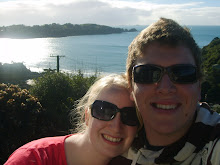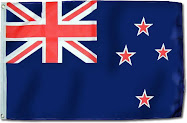 Paihia is the main tourist town in the Bay of Islands in the far north of the North Island of New Zealand. It is located close to the historic towns of Russell, and Kerikeri, 60 kilometres north of Whangarei. This is where New Zealand's first game of cricket was held.
Paihia is the main tourist town in the Bay of Islands in the far north of the North Island of New Zealand. It is located close to the historic towns of Russell, and Kerikeri, 60 kilometres north of Whangarei. This is where New Zealand's first game of cricket was held.Nearby is the historic settlement of Waitangi to the north, and the residential and commercial areas of Haruru Falls; the township of Opua to the south and the small settlement of Te Haumi to the West. It has a population of 1836.
Russell, formerly known as Kororareka, was the first permanent European settlement and sea port in New Zealand. It is situated in the Bay of Islands, in the far north of the North Island. As at the 2001 census it had a resident population of 804, now risen to around 1,100, though much of the accommodation in the area consists of holiday homes or is for tourist use.
When European and American ships began visiting New Zealand in the early 1800s the indigenous Māori quickly recognised there were great advantages in trading with these strangers, who they called tauiwi.
The Bay of Islands offered a safe anchorage and had a high Māori population. To attract ships, Māori began to supply food and timber. What Māori wanted were respect, plus firearms, alcohol, and other goods of European manufacture.
Kororareka developed as a result of this trade but soon earned a very bad reputation, a community without laws and full of prostitution, and became known as the "Hell Hole of the Pacific". European law had no influence and Māori law was seldom enforced within the town's area.
 By 1840 it was an important mercantile centre and served as a vital resupply port for whaling and sealing operations. When the Colony of New Zealand was founded in that year, Governor Hobson was reluctant to choose Kororareka as his capital, due to its bad reputation. Instead he purchased land at Okiato, situated nine kilometres to the south, and renamed it Russell in honour of the Secretary of State for the Colonies, Lord John Russell. A year later the capital was moved to Auckland.
By 1840 it was an important mercantile centre and served as a vital resupply port for whaling and sealing operations. When the Colony of New Zealand was founded in that year, Governor Hobson was reluctant to choose Kororareka as his capital, due to its bad reputation. Instead he purchased land at Okiato, situated nine kilometres to the south, and renamed it Russell in honour of the Secretary of State for the Colonies, Lord John Russell. A year later the capital was moved to Auckland. In 1841-2, Jean Baptiste Pompallier established a Roman Catholic Mission in Russell, which contained a printing press for the production of Māori-language religious texts. His building, known as Pompallier Mission, remains in the care of the New Zealand Historic Places Trust. At the beginning of the Flagstaff War in 1845, the town of Kororareka / Russell was sacked by Hone Heke, after diversionary raids drew away the British defenders. The flagstaff was felled for the fourth time, and the inhabitants fled aboard British ships, which then shelled and destroyed most of the houses.
Kororareka was part of the Port of Russell and after Russell (Okiato) became virtually deserted, Kororareka gradually became known as Russell also. In January 1844 Governor Robert FitzRoy officially designated Kororareka as part of the township of Russell. Today the name Russell applies only to Kororareka while the former capital is known either by its original name of Okiato or as Old Russell.
 Russell is now mostly a "bastion of cafés, gift shops and B&Bs. Pompallier Mission, the historic printery / tannery / storehouse of the early missionaries, can also boast to be the oldest surviving industrial building in New Zealand, while the town also holds Christ Church, the country's oldest surviving church. The surrounding area also contains many expensive holiday homes, as well as New Zealand's most expensive rental accommodation, the Eagles Nest. The car ferry across the Bay of Islands, the main tourist access to Russell, runs between Okiato and Opua.
Russell is now mostly a "bastion of cafés, gift shops and B&Bs. Pompallier Mission, the historic printery / tannery / storehouse of the early missionaries, can also boast to be the oldest surviving industrial building in New Zealand, while the town also holds Christ Church, the country's oldest surviving church. The surrounding area also contains many expensive holiday homes, as well as New Zealand's most expensive rental accommodation, the Eagles Nest. The car ferry across the Bay of Islands, the main tourist access to Russell, runs between Okiato and Opua.
 Russell is now mostly a "bastion of cafés, gift shops and B&Bs. Pompallier Mission, the historic printery / tannery / storehouse of the early missionaries, can also boast to be the oldest surviving industrial building in New Zealand, while the town also holds Christ Church, the country's oldest surviving church. The surrounding area also contains many expensive holiday homes, as well as New Zealand's most expensive rental accommodation, the Eagles Nest. The car ferry across the Bay of Islands, the main tourist access to Russell, runs between Okiato and Opua.
Russell is now mostly a "bastion of cafés, gift shops and B&Bs. Pompallier Mission, the historic printery / tannery / storehouse of the early missionaries, can also boast to be the oldest surviving industrial building in New Zealand, while the town also holds Christ Church, the country's oldest surviving church. The surrounding area also contains many expensive holiday homes, as well as New Zealand's most expensive rental accommodation, the Eagles Nest. The car ferry across the Bay of Islands, the main tourist access to Russell, runs between Okiato and Opua.

No comments:
Post a Comment